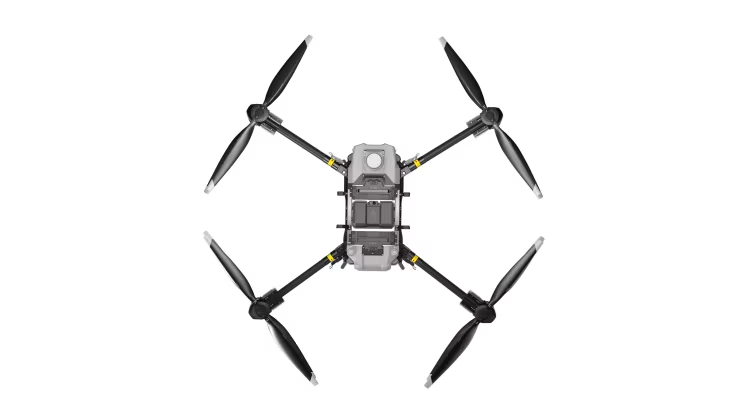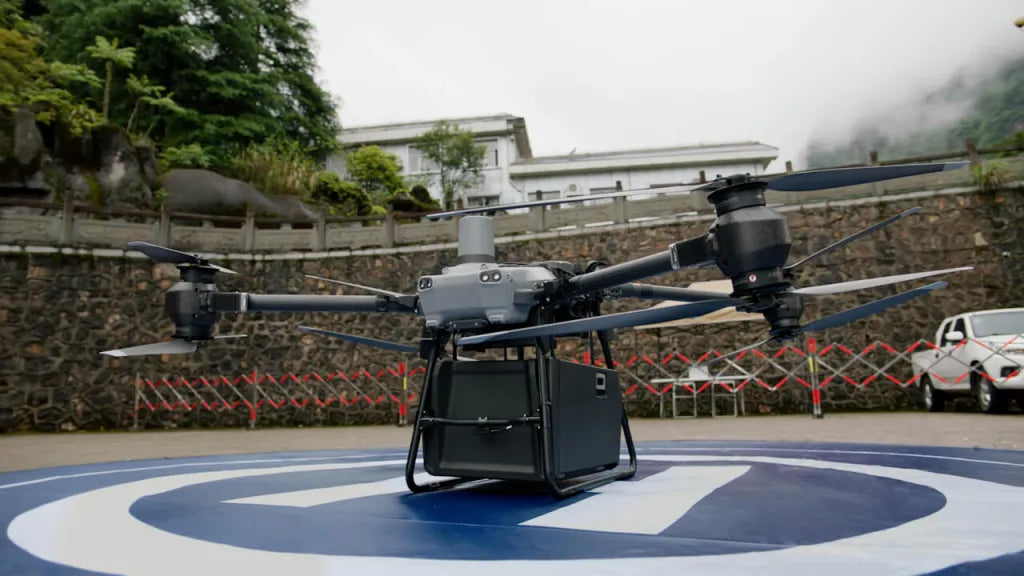DJI FLYCART 30
Dynamic Aerial Delivery

WELCOME TO THE
Future of delivery
The DJI FlyCart 30 is here to deliver the goods. A long-distance heavy lifter with powerful signal and intelligence, DJI FlyCart 30 supports Cargo mode and Winch mode and ascends beyond traditional logistical limits to deliver a safe, economical, and efficient air transport solution.
HIGHLY CAPABLE
30 kg Max Payload[1]
28 km Flight Distance Without Payload[2]
16 km Flight Distance with Full Payload[3]
20 m/s Max Speed[4]
The first three indicators are measured in dual battery mode
Built for Extremes
6,000 m Max Flight Altitude[5]
-20° to 45° C (-4° to 113° F) Operating Temperature[6]
12 m/s Max Wind Speed Resistance[7]
Strong Signal
20 km Video Transmission with O3[8]
4G Enhanced Video Transmission[9]
Dual Operator Mode[10]
High-Resolution FPV Gimbal Camera
Advanced Safety and Intelligence
IP55 Protection and Corrosion Resistance[11]
Radars, Binocular Vision, Intelligent Obstacle Sensing[12]
Dual Batteries and Parachute
Convenient Configurations
Foldable
70 L EPP Case[13]
Winch System
Fully-Automatic Operations
DJI Pilot 2
DJI DeliveryHub
Health Management System

Send What's Needed, Where It's Needed
Heavy payload capacity and long flight distance overcome logistical limitations for next-generation delivery. The FlyCart has a max payload of 30kg (Dual Batteries) [1] or a 40kg Max Payload (Single Battery) [1]

Deliver With Safety and Reliability
Ensured safety from takeoff to landing. Multiple features assure safe takeoff and landing, including sound and light prompts, a 6s delay of propeller rotation, and secondary confirmation of landing. Integrate an RTK module to achieve centimeter-level positioning to further improve takeoff and landing safety.

Strong Signal, Stable Transmission
DJI FlyCart 30 supports DJI O3 video transmission over up to 20 km.[8]
Its four-antenna transceiver system intelligently selects the optimal antenna to transmit signals and enhance anti-interference capabilities. Bolster connection and stability with a DJI Cellular Dongle,[15]which can work in tandem with DJI O3 video transmission. If O3 video transmission experiences interference, the 4G network can maintain signal stability and video transmission, improving flight safety even in complex environments.

Smooth Effortless Control
DJI RC Plus has a 7-inch high-bright screen and supports Dual Operator mode[10]. This mode allows two operators to conveniently transfer control permissions to meet diverse operation requirements.






DJI
DJI Flycart 30
* Please check and strictly abide by local laws and regulations before flying.
** All data was tested with a production model DJI FlyCart 30 in a controlled environment. Actual experience may vary depending on the environment, usage, and firmware version.
*** All videos and images on this page were shot in strict compliance with relevant local laws and regulations.
**** Before use, DJI FlyCart 30 must be activated by using the DJI Pilot 2 app.
1. Measured at sea level. Please pay attention to the difference between single and dual battery states. The maximum loaded weight must not exceed the recommended value. Avoid placing sharp objects when using cargo cases. Avoid goods hitting the landing gear when using the winch system. Otherwise, flight safety may be compromised.
2. Measured with DJI FlyCart 30 (operating on dual batteries) flying at a constant 15 m/s in a windless environment at sea level without payloads until displayed battery level reached 0%. Data is for reference only. Please pay attention to the Return to Home (RTH) prompts in the DJI Pilot 2 app during your flights.
3. Measured with DJI FlyCart 30 (operating on dual batteries) flying at a constant 15 m/s in a windless environment at sea level with a full payload until displayed battery level reached 0%. Data is for reference only. Please pay attention to the Return to Home (RTH) prompts in the DJI Pilot 2 app during your flights.
4. Measured with DJI FlyCart 30 (operating on dual batteries) flying with a full payload in a windless environment at sea level. Data is for reference only.
5. The load capacity of DJI FlyCart 30 decreases as the takeoff altitude increases. An altitude of 6,000 meters is the maximum safe altitude for DJI FlyCart 30 flying in dual batteries mode without a payload (takeoff at an altitude of 4,500 meters). An altitude of 3,000 meters is the maximum safe altitude for DJI FlyCart 30 flying with a full payload.
6. Measured with estimated solar radiation of 960 W/m2. Long-term exposure to high temperatures may shorten the service life of certain components.
7. During takeoff and landing, DJI FlyCart 30 can resist a maximum wind speed of 12 m/s.
8. Measured with FCC compliance in an unobstructed environment with low interference. Data is for reference only. During your flight, please pay attention to reminders in the app.
9. To realize 4G enhanced video transmission, connect the DJI FlyCart 30's DJI Cellular Dongle (available only in the Chinese mainland) to the internet. The remote controller can be connected to the internet by using the DJI enhanced video transmission module or the Wi-Fi module.
10. A second remote controller is sold separately.
11. The protection rating is not permanent and may decline due to aging and wear caused by long-term use. The protection rating does not apply to the propulsion system. After a flight in rain, it is recommended to keep it idling on the ground for 1 minute to prevent corrosion or rust to afflict the propulsion system (precipitation of more than 24.9 mm within 24 hours).
12. Effective sensing range and obstacle sensing capabilities may vary depending on ambient light, rain, fog, and the material, position, shape, and other properties of the obstacles. Downward sensing is mainly used to assist in measuring ground clearance. Sensing in other directions is used for obstacle sensing.
13. The dimensions of the Expanded Polypropylene (EPP) case interior are 573×416×306 mm (L×W×H).
14. When DJI FlyCart 30 operates on dual batteries and flies in a 25° C windless environment at sea level with a full payload, the lowest height for opening the parachute is 60 m and the terminal descent speed 6 m/s.
15. The DJI enhanced video transmission module is sold separately and available only in the Chinese mainland.
16. Measured under lab conditions at 25° C in a windless environment and at sea level.
17. Center of gravity and weight detection are not permanently valid. Please perform tare calibration as needed.
18. 2.5D Base Map is a 2D map overlaid with elevation data.
19. Battery provides 1,500 in-warranty cycles or a 12-month warranty, whichever comes first.
20. When fast charging a single battery, make sure that the charger uses two 220 V cables at the same time and that the power line and socket can withstand the charging power.
21. Theoretical maximum power of the charger. Actual power may vary based on voltage.
22. Sold separately.


